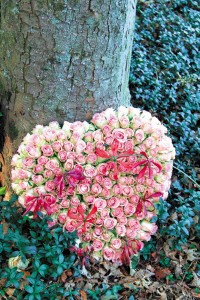When it comes to the passing of a loved one, many ask what is best when handling cremated remains. Here are several options when deciding whether to scatter or store
QUESTION OF THE WEEK: A group of us who read your column gather regularly. We often have discussions about your weekly topics. A recent discussion was about the ashes of those who have passed — both humans and pets. We wonder, is it OK to keep them in the home? If so, where? If not, what do you suggest we do with them? Some of us have ashes of our loved ones in our home from many years ago, and would like any insight you can share on this topic. Thank you.
Some of you may or may not know that the same day I opened Happiness U, on Sept. 1, 2013, was the same day I retired from officiating wedding ceremonies and memorial services. Although I have close to 900 wedding ceremonies under my belt, I also have more than a dozen years of experience helping people with the transition of loved ones — both from the perspective of the celebration of the loved one’s life, to answering the question that you have posed, “What do we do with the ashes?” I’d like to answer your questions from my experience as a minister, and from the feng shui perspective.
First of all, no “right” or “wrong” way exists to deal with the ashes of a loved one. What matters most is the deceased’s wishes. If the deceased has not made his or her wishes known, then what is right for you is most important. Often, in the latter situation, the remains are often stored somewhere in a relative’s home, usually because no one knows what to do with them. I’ve seen ashes on a mantelpiece, next to one’s bed, in the closet, and in places you can’t imagine.
According to the Cremation Association of North America (CANA), one-third of people who receive cremains bury them, one-third scatter them, and the last third keep them. Let’s address these three options.
Burying or scattering the ashes
A ceremony usually accompanies burying or scattering the ashes. The ceremony is entirely up to you. Some ceremonies may be elaborate, and others may be sweet and simple. When the time is right, it can feel good to let go of this final contact with your loved one, as it indicates acceptance and completion.
You can scatter the ashes in your loved one’s favorite spot — a park, beach, golf course, hiking trail, or garden, just to name a few. You can even plant a rose or tree in the garden and bury the ashes there, with or without the urn.
Ways to scatter the ashes
You can scatter the ashes in a myriad of ways, including using a scattering urn to disperse them, making things much easier.
• Casting ashes. This is the simple act of tossing the ashes to the wind. Make sure you cast downwind.
• Trenching ashes. This commemoration involves digging a shallow trench or groove in the soil and filling it from the scattering urn, then raking it over at the conclusion of the ceremony. You can be creative and dig the person’s name into the soil, or draw a heart in the soil, filling the void with the ashes.
• Ringing ashes. In this ceremony, you use the scattering urn to form a ring of ashes on the ground around an object, group of objects, tree, or shrub, with or without a trench.
• Raking ashes. In this instance, the ashes are poured evenly on loose soil and raked into the ground at the conclusion of the ceremony.
• Scattering ashes over water. Some people scatter their loved one’s ashes over a large or small body of water. You can pour the ashes into the water, or you can use a water-soluble urn to enhance the experience. These urns are specifically designed to gradually disperse the ashes back to the sea and will usually float for several minutes then slowly sink where it will naturally degrade.
Keeping ashes at home
Some think keeping the ashes at home is gruesome and improper, and others feel it’s the only way to keep the loved one or four-legged friend nearby. Sometimes the ashes remain at home because of indecision or unresolved feelings of grief and loss.
In feng shui, keeping ashes of a loved one is a “no-no,” based on the fact that it is “dead” and “negative” energy. From my understanding, everyone is different in how death is processed. I have seen many cases where the advantages of keeping the ashes outweigh the disadvantages. It all depends on you and where you are in the grieving process.
As for location, if you want to follow feng shui placement, the “helpful people” area, located at the far right, front corner of your home (as you stand at your front door facing inwards), is the best place for them. You might even want to place a framed photo of your loved one with the urn.
Finally, check in with yourself and make sure that you feel 100 percent good about your choices when dealing with the remains.
Alice Inoue is the founder and Chief Happiness Officer at Happiness U, a friendly and warm educational establishment at Gentry Pacific Center on Nimitz Highway. At Happiness U, one can learn how to be happy, a subject you won’t find in a traditional school. Happiness U offers classes such as feng shui 101, clutter clearing plan 101, positive mindset 101, happiness 101 and more. Visiti www.YourHappinessU.com.
